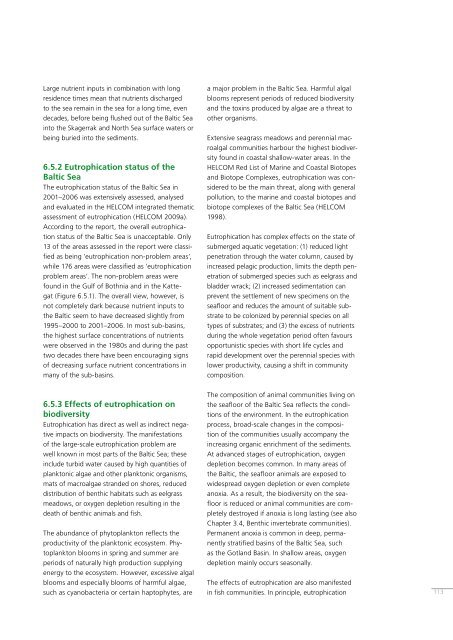BSEP116B Biodiversity in the Baltic Sea - Helcom
BSEP116B Biodiversity in the Baltic Sea - Helcom
BSEP116B Biodiversity in the Baltic Sea - Helcom
Create successful ePaper yourself
Turn your PDF publications into a flip-book with our unique Google optimized e-Paper software.
Large nutrient <strong>in</strong>puts <strong>in</strong> comb<strong>in</strong>ation with long<br />
residence times mean that nutrients discharged<br />
to <strong>the</strong> sea rema<strong>in</strong> <strong>in</strong> <strong>the</strong> sea for a long time, even<br />
decades, before be<strong>in</strong>g flushed out of <strong>the</strong> <strong>Baltic</strong> <strong>Sea</strong><br />
<strong>in</strong>to <strong>the</strong> Skagerrak and North <strong>Sea</strong> surface waters or<br />
be<strong>in</strong>g buried <strong>in</strong>to <strong>the</strong> sediments.<br />
6.5.2 Eutrophication status of <strong>the</strong><br />
<strong>Baltic</strong> <strong>Sea</strong><br />
The eutrophication status of <strong>the</strong> <strong>Baltic</strong> <strong>Sea</strong> <strong>in</strong><br />
2001–2006 was extensively assessed, analysed<br />
and evaluated <strong>in</strong> <strong>the</strong> HELCOM <strong>in</strong>tegrated <strong>the</strong>matic<br />
assessment of eutrophication (HELCOM 2009a).<br />
Accord<strong>in</strong>g to <strong>the</strong> report, <strong>the</strong> overall eutrophication<br />
status of <strong>the</strong> <strong>Baltic</strong> <strong>Sea</strong> is unacceptable. Only<br />
13 of <strong>the</strong> areas assessed <strong>in</strong> <strong>the</strong> report were classified<br />
as be<strong>in</strong>g ’eutrophication non-problem areas’,<br />
while 176 areas were classified as ‘eutrophication<br />
problem areas’. The non-problem areas were<br />
found <strong>in</strong> <strong>the</strong> Gulf of Bothnia and <strong>in</strong> <strong>the</strong> Kattegat<br />
(Figure 6.5.1). The overall view, however, is<br />
not completely dark because nutrient <strong>in</strong>puts to<br />
<strong>the</strong> <strong>Baltic</strong> seem to have decreased slightly from<br />
1995–2000 to 2001–2006. In most sub-bas<strong>in</strong>s,<br />
<strong>the</strong> highest surface concentrations of nutrients<br />
were observed <strong>in</strong> <strong>the</strong> 1980s and dur<strong>in</strong>g <strong>the</strong> past<br />
two decades <strong>the</strong>re have been encourag<strong>in</strong>g signs<br />
of decreas<strong>in</strong>g surface nutrient concentrations <strong>in</strong><br />
many of <strong>the</strong> sub-bas<strong>in</strong>s.<br />
a major problem <strong>in</strong> <strong>the</strong> <strong>Baltic</strong> <strong>Sea</strong>. Harmful algal<br />
blooms represent periods of reduced biodiversity<br />
and <strong>the</strong> tox<strong>in</strong>s produced by algae are a threat to<br />
o<strong>the</strong>r organisms.<br />
Extensive seagrass meadows and perennial macroalgal<br />
communities harbour <strong>the</strong> highest biodiversity<br />
found <strong>in</strong> coastal shallow-water areas. In <strong>the</strong><br />
HELCOM Red List of Mar<strong>in</strong>e and Coastal Biotopes<br />
and Biotope Complexes, eutrophication was considered<br />
to be <strong>the</strong> ma<strong>in</strong> threat, along with general<br />
pollution, to <strong>the</strong> mar<strong>in</strong>e and coastal biotopes and<br />
biotope complexes of <strong>the</strong> <strong>Baltic</strong> <strong>Sea</strong> (HELCOM<br />
1998).<br />
Eutrophication has complex effects on <strong>the</strong> state of<br />
submerged aquatic vegetation: (1) reduced light<br />
penetration through <strong>the</strong> water column, caused by<br />
<strong>in</strong>creased pelagic production, limits <strong>the</strong> depth penetration<br />
of submerged species such as eelgrass and<br />
bladder wrack; (2) <strong>in</strong>creased sedimentation can<br />
prevent <strong>the</strong> settlement of new specimens on <strong>the</strong><br />
seafloor and reduces <strong>the</strong> amount of suitable substrate<br />
to be colonized by perennial species on all<br />
types of substrates; and (3) <strong>the</strong> excess of nutrients<br />
dur<strong>in</strong>g <strong>the</strong> whole vegetation period often favours<br />
opportunistic species with short life cycles and<br />
rapid development over <strong>the</strong> perennial species with<br />
lower productivity, caus<strong>in</strong>g a shift <strong>in</strong> community<br />
composition.<br />
6.5.3 Effects of eutrophication on<br />
biodiversity<br />
Eutrophication has direct as well as <strong>in</strong>direct negative<br />
impacts on biodiversity. The manifestations<br />
of <strong>the</strong> large-scale eutrophication problem are<br />
well known <strong>in</strong> most parts of <strong>the</strong> <strong>Baltic</strong> <strong>Sea</strong>; <strong>the</strong>se<br />
<strong>in</strong>clude turbid water caused by high quantities of<br />
planktonic algae and o<strong>the</strong>r planktonic organisms,<br />
mats of macroalgae stranded on shores, reduced<br />
distribution of benthic habitats such as eelgrass<br />
meadows, or oxygen depletion result<strong>in</strong>g <strong>in</strong> <strong>the</strong><br />
death of benthic animals and fish.<br />
The abundance of phytoplankton reflects <strong>the</strong><br />
productivity of <strong>the</strong> planktonic ecosystem. Phytoplankton<br />
blooms <strong>in</strong> spr<strong>in</strong>g and summer are<br />
periods of naturally high production supply<strong>in</strong>g<br />
energy to <strong>the</strong> ecosystem. However, excessive algal<br />
blooms and especially blooms of harmful algae,<br />
such as cyanobacteria or certa<strong>in</strong> haptophytes, are<br />
The composition of animal communities liv<strong>in</strong>g on<br />
<strong>the</strong> seafloor of <strong>the</strong> <strong>Baltic</strong> <strong>Sea</strong> reflects <strong>the</strong> conditions<br />
of <strong>the</strong> environment. In <strong>the</strong> eutrophication<br />
process, broad-scale changes <strong>in</strong> <strong>the</strong> composition<br />
of <strong>the</strong> communities usually accompany <strong>the</strong><br />
<strong>in</strong>creas<strong>in</strong>g organic enrichment of <strong>the</strong> sediments.<br />
At advanced stages of eutrophication, oxygen<br />
depletion becomes common. In many areas of<br />
<strong>the</strong> <strong>Baltic</strong>, <strong>the</strong> seafloor animals are exposed to<br />
widespread oxygen depletion or even complete<br />
anoxia. As a result, <strong>the</strong> biodiversity on <strong>the</strong> seafloor<br />
is reduced or animal communities are completely<br />
destroyed if anoxia is long last<strong>in</strong>g (see also<br />
Chapter 3.4, Benthic <strong>in</strong>vertebrate communities).<br />
Permanent anoxia is common <strong>in</strong> deep, permanently<br />
stratified bas<strong>in</strong>s of <strong>the</strong> <strong>Baltic</strong> <strong>Sea</strong>, such<br />
as <strong>the</strong> Gotland Bas<strong>in</strong>. In shallow areas, oxygen<br />
depletion ma<strong>in</strong>ly occurs seasonally.<br />
The effects of eutrophication are also manifested<br />
<strong>in</strong> fish communities. In pr<strong>in</strong>ciple, eutrophication<br />
113

















